Exploring the Significance of 3.5 Carat Gemstones
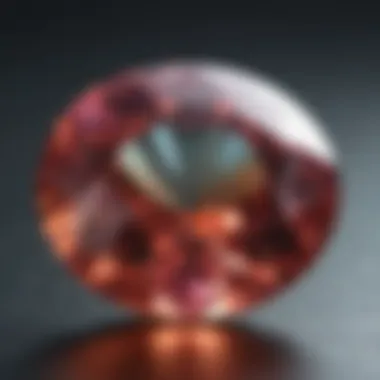
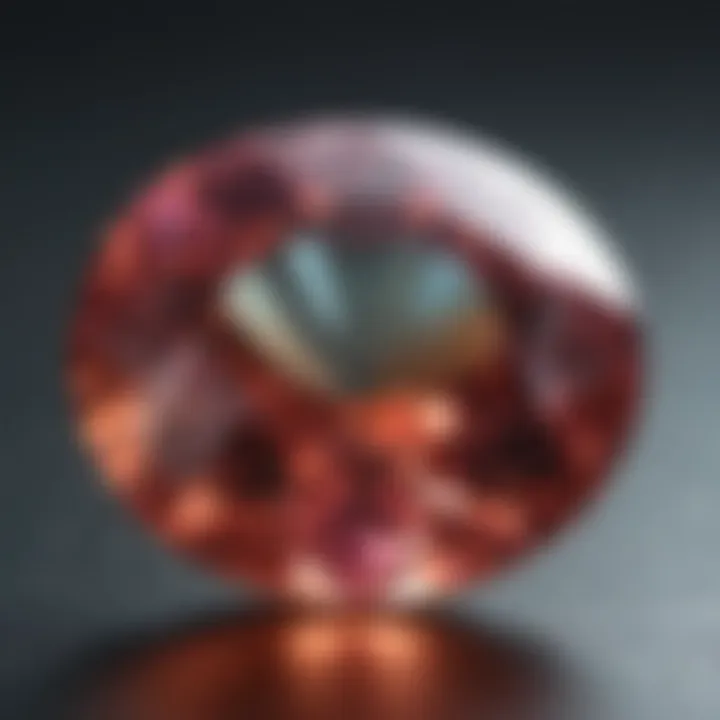
Intro
When you think of gemstones, the first image that often comes to mind is that of a glittering jewel, perhaps set in a ring or necklace. A 3.5-carat gemstone intrigues many, harboring a mix of beauty and significant value. But what does it really mean to own one? There are layers to this topic, extending beyond mere aesthetics to a deeper appreciation and understanding of the gemstone itself. We'll explore the multifaceted world of a 3.5-carat gemstone, diving into its characteristics and historical roots, all while keeping an eye on contemporary market trends.
Gemstone Overview
Definition and Characteristics
A carat is a standard measurement used to quantify the weight of gemstones, with one carat equaling 200 milligrams. So, naturally, a 3.5-carat gemstone measures significantly larger than its lesser counterparts, making it a focal point within any jewelry piece. But it’s not just about size; other characteristics such as cut, clarity, and color play a massive role in determining a gemstone’s overall value. Each of these attributes combines to create a beautiful balance, often drawing admirers from afar.
Here are key characteristics to consider:
- Cut: This refers to how well the gemstone has been shaped and faceted. A skillfully cut stone sparkles brilliantly.
- Clarity: This involves the presence of internal or external flaws. A higher clarity often equates to greater value.
- Color: The deeper or more vivid the color, the more desirable (and valuable) the stone.
These factors don’t just influence appearances; they also determine how well the gemstone holds its value over time.
Classification of Gemstones
Gemstones can broadly be classified into two categories: precious and semi-precious. Traditionally, gemstones like diamonds, sapphires, rubies, and emeralds are labeled as precious due to their rarity and high value.
However, this classification isn’t as rigid as it once was. Many semi-precious stones, such as tanzanite and alexandrite, have seen their value increase dramatically in recent years. 3.5-carat gemstones produce an allure that transcends these classifications; they can fit into both categories depending on their unique characteristics.
"In the world of gemstones, beauty and value often chase each other like a cat and a laser pointer, constantly shifting and redefining what we hold dear."
Historical Significance
Ancient Uses and Cultural Importance
Gemstones have been a part of human culture for millennia. In ancient times, they were not only used for adornment but also for practical applications, like talismans or as currency in trade. Kings and queens adorned themselves with these precious stones as symbols of power and prestige.
Every culture has its beliefs about gemstones. For instance, ancient Egyptians revered lapis lazuli, associating it with the heavens and the afterlife. Similarly, in the Indian culture, they believed that wearing gemstones could influence one’s destiny. Thus, the significance of a 3.5-carat piece goes beyond mere aesthetics; it carries a rich fabric of history, encapsulating millennia of stories and messages.
Myths and Legends Surrounding Gemstones
The lore surrounding gemstones is as vast as the stones themselves. Each gem comes with its own tales, often passed down through generations. For example, diamonds were thought to bring protection and strength while sapphires were associated with wisdom and royalty.
In some legends, a 3.5-carat gemstone could even serve as a bridge between the earthly realm and the divine. Such beliefs continue to inform collectors and buyers even today. They may choose a gemstone not only for its beauty but also for the stories and energies it embodies.
The enchantment of gemstones is undeniable, and for those engaged in the intricate world of gemstones, understanding their complexities is as important as appreciating their beauty.
Preface to Carat Weight
Understanding carat weight is foundational for anyone stepping into the realm of gemstones. The weight of a gemstone, particularly in the context of the jewelry industry, affects numerous factors including price, appearance, and desirability. In this article, we will delve into the elements surrounding carat weight, especially focusing on the significance of a 3.5 carat gemstone in today’s market.
Defining Carat and Its Importance
Carat, commonly symbolized as "ct," is a unit of weight used specifically to measure gemstones. One carat equals 200 milligrams, which means a 3.5 carat gemstone weighs an impressive 700 milligrams. It's essential to understand that carat weight does not directly equate to size; different gemstones have varying densities, which can result in a smaller or larger appearance despite weighing the same. Therefore, when looking at gemstones, a clearer understanding of carat can help buyers make informed choices based on appearance rather than just weight.
Why does this matter? A 3.5 carat gem often stands out prominently, catching the eye and radiating a sense of prestige. Its significance extends beyond just being a beautiful piece of jewelry; it represents a level of investment, status, and personal expression. As more people search for unique pieces to complement their style, knowing the intricacies of carat weight becomes crucial.
The Evolution of Carat Measurements
Historically, gemstones were measured using arbitrary weights and local systems, which often led to inconsistencies. The term "carat" is believed to derive from the carob seeds once used as balance scales in the market. Each carob seed weighed approximately one carat, establishing the basis for a standardized measurement.
Over time, the modern system of measurement was adopted, and the values were standardized internationally through institutions that pushed for uniformity. This evolution reflected a growing demand within the gemstone market for reliability in transactions, ensuring that buyers and sellers could trust the weight and value of the gemstones they dealt with.
Emerging from this historical context, the current carat weight system not only serves as a measurement but is intertwined with the societal value assigned to stones. Thus, each increment in carat weight has its impact. A transition from, say, a 3 carat stone to a 3.5 carat stone is more than just change in weight; it's often seen as a leap in luxury and desirability.
Through this exploration of carat weight, we can appreciate the nuances and historical significance behind protecting values in today's jewelry marketplace.
Significance of a 3. Carat Gemstone
The significance of a 3.5 carat gemstone extends beyond its size and weight. It encapsulates a blend of market perception, cultural implications, and emotional connections, making it a valuable acquisition for enthusiasts and collectors alike.
Market Perception and Desirability
In the realm of gemstones, size often influences market perception more than one might anticipate. A gemstone weighing 3.5 carats sits comfortably within the category of high-value items. For many, it symbolizes status and luxury. The desirability of such a stone often spurs higher demand among consumers, particularly those looking to make a statement in jewelry.
But it's essential to consider that the desirability of these stones isn't solely about their weight. The market also acknowledges the quality of the cut, color, and clarity—commonly known as the 4Cs. For instance, a well-cut 3.5 carat diamond may be more sought after than a poorly cut larger stone. Shoppers are drawn to stones that not only sparkle but also reflect light beautifully.
"The allure of gemstones often lies in their ability to evoke emotions and personal connections, transforming a mere adornment into a significant treasure."
Furthermore, societal trends often influence the market's perception. In recent years, there has been a growing interest in ethically sourced gemstones, impacting choices for many buyers. This not only bolsters the perceived value of a 3.5 carat stone but also aligns with the ethical considerations of consumers.
Cultural References and Symbolism
Culturally, gemstones are rich with symbolism. A 3.5 carat gem often represents love and commitment, making it a popular choice for engagement rings. It resonates with traditions, where larger stones are associated with lasting love and prosperity. Different cultures attribute varying meanings to gemstones. For instance, in some traditions, a diamond represents eternity, while in others, its brilliance symbolizes clarity and commitment in relationships.
Moreover, beyond personal adornment, gemstones carry historical significance. Royalty and influential figures have, throughout history, adorned themselves with large, stunning stones. The 3.5 carat weight has often been chosen by those desiring both beauty and statement—a nod to their power and prominence.
Grading and Evaluation Metrics
When considering the value and significance of a 3.5 carat gemstone, it’s imperative to delve into grading and evaluation metrics. This portion provides the framework through which gemstones are assessed, helping buyers and sellers alike grasp a gemstone's true worth. Diligent assessment not only sheds light on the quality of the stone but also shapes market dynamics and influences consumer trust.
The 4Cs: Cut, Color, Clarity, and Carat
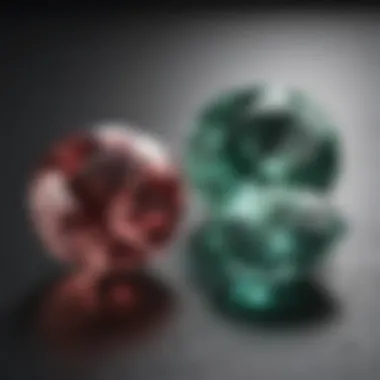
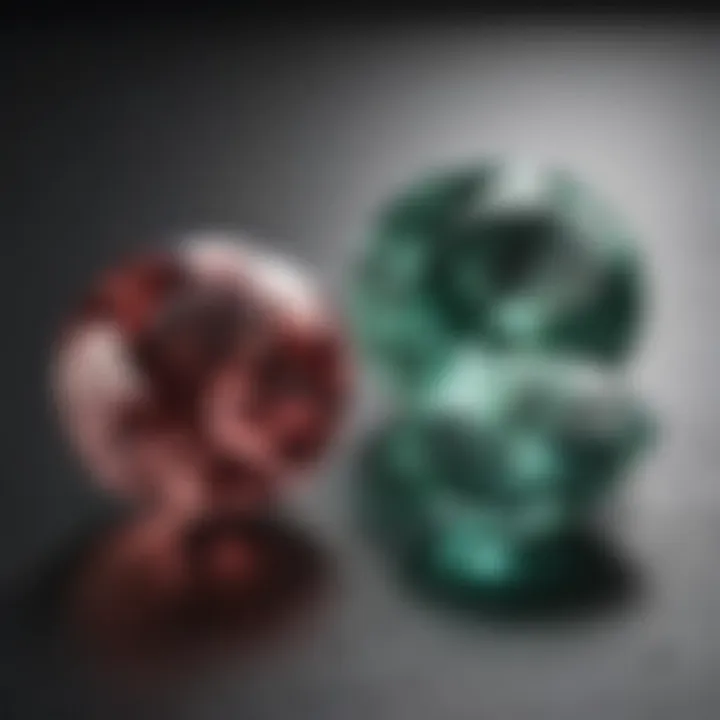
The so-called 4Cs stand as the cornerstone of gemstone evaluation. Understanding these fundamental categorizations not only empowers buyers but also supports a better appreciation of the aesthetic appeal and intrinsic value of gemstones. Each factor possesses specific attributes worth examining:
- Cut: More than just shape, cut refers to how well the stone has been shaped and faceted. A well-cut gemstone maximizes light return and adds brilliance, whereas a poorly cut one can make even the finest stone appear dull. For instance, a round brilliant cut will generally fetch more than an equivalent stone in a less popular cut, such as a baguette.
- Color: For colored gemstones, this is one of the most critical attributes. The richness of a color can make or break its desirability. In gems like sapphires or rubies, deep, vivid hues usually command better prices. Notably, the presence of secondary hues can either enhance or diminish a stone's overall value, adding another layer to consider for the discerning buyer.
- Clarity: This metric examines the internal and external flaws of the gemstone. A stone with high clarity — meaning few or no inclusions — typically holds higher value. For instance, a 3.5 carat diamond with VVS clarity may catch the eye of collectors more readily than one with visible inclusions. It’s about how cleanly a stone catches light, which directly influences its sparkle.
- Carat: Finally, carat weight measures the size of the gemstone. As the weight increases, so does the price; however, the relationship isn't linear. Not only does size matter, but the accompanying cut, color, and clarity equally contribute to the overall value.
Understanding the 4Cs gives you a solid base when evaluating any gemstone, especially 3.5 carat stones, where each nuance can carve a distinct pathway in pricing and desirability.
Understanding Gemstone Grading Reports
A gemstone grading report acts like a report card for the stone, detailing its features in an objective manner. It is crucial for anyone looking to buy or invest in gemstones. The beauty of these reports lies in their transparency; they help bridge the gap between buyer expectations and actual value.
Here’s what you can expect from a typical grading report:
- Certification by a GIA or AGS Lab: These are among the most reputable institutions, and their stamp of approval reaffirms the stone's quality.
- Detailed Measurements: The report contains specific dimensions, which provide insight into the stone's proportions. This can inform decisions about potential mounting or resale.
- Color and Clarity Grades: Expect to find detailed scales explaining color grading and clarity, alongside visuals that assist in understanding the stone's appearance.
- Comments on Cut Quality: An overview of how well a gemstone has been cut can clarify why it reflects light the way it does.
- Photographs: Many reports come with photos, providing an at-a-glance view of the stone's properties.
"Investing in a graded gemstone is not just about the stone but also about the gemstone grading report. It's your safety net in a market full of uncertainty."
Knowing how to read these reports is indispensable for any serious buyer. It's more than numbers and grades; each detail tells a story of artistry, quality, and authenticity that aids in preserving one's investment in a gemstone.
Comparing Carat Weights
When it comes to gemstones, understanding carat weight is crucial for both buyers and collectors. Carat weight greatly influences not just the price but also the perceived value and aesthetics of the gemstone. Comparing carat weights reveals intriguing insights into what drives desirability in the marketplace. While many focus on size, other factors contribute to how a gemstone is valued. This section elaborates on the nuances linked to comparing different carat weights, particularly emphasizing the aspects of 3.5 carat stones in contrast to their lighter and heavier counterparts.
3. Carat vs. Carat Stones
A 3.5 carat gemstone often represents a significant upgrade in both appearance and investment potential when juxtaposed against a 2 carat stone. The difference in carat weight, while seeming incremental, results in a noticeable shift in size and visibility. Here’s how these two dimensions stack up:
- Visibility: A 3.5 carat stone tends to catch the eye significantly more than a 2 carat. Buyers often seek this visual impact, as the larger stone makes a bolder statement in jewelry.
- Value: Generally, the price per carat rises exponentially with weight. Thus, while a 2 carat stone might be more budget-friendly, a 3.5 carat stone often serves as a better investment over time.
- Market Demand: Jewelers frequently report that larger stones like the 3.5 carat maintain more steady demand than their smaller counterparts. This can be attributed to a broad cultural perception of larger gemstones being more prestigious.
From a purely aesthetic perspective, the characteristics of the gem—cut, clarity, and color—remain essential variables in the valuation equation. However, simply observing the visual differences can make a strong case for the preference of a 3.5 carat stone over a 2 carat option.
3. Carat vs. Carat Stones
In comparing a 3.5 carat gemstone to its 4 carat counterpart, the distinctions can be both subtle and significant. While the jump from 2 to 3.5 carats shows a pronounced difference, the leap from 3.5 to 4 carats is less dramatic in size but can be considerable from a financial standpoint.
To really understand the implications:
- Perceived Value: A stone that weighs 4 carats is often viewed as a luxury. However, the incremental difference in size from 3.5 carats does not always justify the notably higher price that comes with the heavier stone. Collectors may find themselves evaluating investment potential against the visual payoff.
- Setting Choices: Jewelry settings for larger stones may need to be designed differently to manage the weight and size effectively. A 4 carat stone might require sturdier and more elaborate settings, which can further affect cost and aesthetic.
- Rarity: Given that finer gems are rarer at higher weights, a 4 carat stone could potentially seem like a more desirable option to some collectors purely based on rarity. However, the market often reflects that 3.5 carat stones balance beauty and affordability exceptionally well.
In summary, while gemstones vary not just in size but in value perception, a careful assessment of weight relative to other grading factors can enhance one's understanding of investment dynamics. "Buying a gemstone is not just about size; it’s about finding what resonates personally and holds future value." This insight highlights the complex interplay between carat weight and the overall gemstone investment experience.
Factors Influencing Price
The price of a 3.5 carat gemstone isn't simply a matter of its weight. Rather, there are multiple pieces of the puzzle that contribute to the overall valuation. Understanding these factors provides buyers, collectors, and enthusiasts a clearer picture of what their investment entails. This section explores market dynamics, rarity, and how these elements intertwine to shape pricing.
Market Trends and Demand
In recent years, the gemstone market has seen some waves of change. The demand for 3.5 carat stones, in particular, reflects broader market trends defined by culture, fashion, and even economies. People are increasingly looking for significant stones that offer not just visual appeal but also status and investment value.
For instance, a surge in the popularity of custom jewelry has elevated the demand for larger, higher-quality gemstones. Properties such as cut and clarity can greatly affect how a stone is perceived in the marketplace. As tastes continue shifting toward distinctive pieces, a well-cut 3.5 carat stone will likely fetch a premium price.
Additionally, social media has played a notable role in driving demand. Platforms like Instagram and Pinterest showcase luxurious lifestyles, often featuring unique gemstone pieces that can influence purchasing decisions. Consequently, a well-marketed gemstone can quickly see its value inflate if it's tied to current trends or prominent figures.
"The market for gemstones is as much about storytelling and trends as it is about intrinsic qualities."
Rarity and Supply Dynamics
Rarity is another heavyweight player when it comes to pricing. A 3.5 carat gemstone that possesses unique characteristics—like a specific shade or an unusual cut—can be hard to come by, thus commanding a higher price point. Moreover, the availability of certain stones varies widely depending on the geographical regions they come from. For example, some gemstones are mined in limited locations, making them scarce.
Let's examine a few key elements:
- Geological factors: Certain gemstones, such as alexandrite or Paraiba tourmaline, are naturally less abundant than more common stones like amethyst or quartz.
- Extraction practices: Ethical and sustainable mining practices can limit the supply of gemstones, as responsible miners may not extract all available resources, prioritizing environmental considerations over sheer volume.
- Economic impacts: Economic conditions can strain supply chains. Issues such as transportation costs and mining regulations can influence how often these stones appear in the market. When demand continues to rise in the face of limited availability, prices can skyrocket.
In summary, the price of a 3.5 carat gemstone dances to the rhythm of market trends, demand, rarity, and supply dynamics. As these factors evolve, they keep the gemstone market vibrant and complex, making the pursuit of the perfect stone an engaging journey.
Investment Potential of 3. Carat Stones
The allure of gemstones extends far beyond their aesthetic beauty; they often hold significant financial value as well. A 3.5 carat gemstone, while not the largest, occupies a sweet spot in the realm of potential investments. With its notable heft, it stands out not just for its size but for the delicate balance it strikes between accessibility and desirability. When considering investment potential, several specific elements come into play.
Evaluating Long-term Value Trends
Investing in gemstones like a 3.5 carat stone offers a fascinating lens into asset appreciation. Historical data suggests that high-quality gemstones tend to appreciate over time, driven by their rarity and increasing demand among collectors. It’s noteworthy that high-demand periods can significantly boost prices.
- Historic Resale Values: Many collectors find that 3.5 carat stones, particularly those with superior cut and clarity, have fetched impressive returns at auctions. Over a decade, these gems have shown an upward trajectory in value.
- Economic Resilience: Unlike more volatile markets, the gemstone sector often remains stable during economic downturns. Investors may look to tangible assets when markets falter, further enhancing the investment appeal of a 3.5 carat gemstone.
- Market Insights: Analysts anticipate a growing trend in the luxury goods sector, where gemstones are seen as both aesthetic pleasures and sound financial assets. Keeping an eye on market trends, especially in affluent demographics, can provide clues to potential future values.
Selecting a high-quality 3.5 carat gemstone involves scrutinizing its attributes closely. Investing in gems isn’t merely about their carat weight; factors like cut, color, and clarity play crucial roles. Understanding these metrics can aid investors in making informed decisions.
“The value of a gemstone isn’t just measured in carats but in the story and quality behind it.”
Diversification Through Gemstone Investment
Diving into gemstone investments, especially with a focus on 3.5 carat stones, provides a unique avenue for diversification. In a portfolio full of stocks and bonds, the inclusion of tangible assets like gemstones can guard against market volatility. Here are a few considered benefits of diversifying through such investments:
- Safe Haven: Gemstones tend to hold inherent value, coming from both sentiment and rarity. Having these in a collection may offer peace of mind, knowing they won't devalue in the same way stocks might falter.
- Liquidity: When needed, gemstones can be sold relatively quickly, especially those with established value in the market. Some investors prefer gemstones to art due to this liquidity ease.
- Aesthetic Appeal: Unlike many investments that collect dust in a portfolio, gemstones can be enjoyed visually too. They bring an element of joy, often becoming family heirlooms or decorative pieces.
Investing in a 3.5 carat gemstone is not a venture to be taken lightly. While it presents significant benefits, potential investors should perform thorough due diligence.


Educating oneself on market trends and individual stone characteristics is essential. Ultimately, diversifying a portfolio with 3.5 carat gemstones can yield rewarding dividends in both tangible and intangible ways.
Care and Maintenance
Caring for a 3.5 carat gemstone not only ensures its luster remains intact but also protects the investment's value from diminishing. Gemstones can be rather delicate, and regular maintenance is critical. It’s not just about aesthetics; proper care can enhance longevity, allowing these stunning pieces to be cherished for generations. Knowing how to maintain a gemstone effectively involves understanding various cleaning methods and suitable storage practices. Let's explore these aspects in detail to give you a more complete perspective.
Cleaning Techniques for Gemstones
Keeping your gemstone clean is more than just a cosmetic concern; it's also a way to prevent damage over time. Here are some effective cleaning techniques that you might find beneficial:
- Mild Soap Wash: For most gemstones, a simple soap solution is the best choice. Mix a few drops of mild liquid soap with warm water and use a soft brush to scrub the stone gently. This method should keep your 3.5 carat gem shining.
- Ultrasonic Cleaners: These can be useful, but be sure to avoid them for softer gemstones like opals or pearls. If you are dealing with a hardy stone like a diamond, an ultrasonic cleaner can effectively remove dirt while preserving its integrity.
- Natural Solutions: Sometimes, nature has the answers. A mixture of white vinegar and olive oil can be used for a natural shine. Just remember to rinse thoroughly to remove any residue.
"A clean gemstone is not only more visually attractive, but it also signifies care and respect for its inherent value."
- Lint-Free Cloths: After cleaning with water or solutions, always dry the gemstone with a lint-free cloth to avoid scratches. This is a small step that can make a big difference.
Storage Recommendations for Value Preservation
Proper storage is essential for maintaining the value of your gemstone. This is especially true for larger stones like a 3.5 carat. Below are some guidelines to consider:
- Separate Storage: Avoid tossing your gemstone into a cluttered jewelry box. Instead, store each piece separately, ideally in a padded box or a fabric pouch. This practice prevents scratches from direct contact with other jewelry.
- Avoid Extreme Conditions: Keep gemstones in a controlled environment. Extreme temperatures or humidity levels can cause damage. A cool, dry place is optimal for preservation.
- Use Anti-Tarnish Materials: Consider using materials that prevent tarnish, especially for silver settings. These can help maintain the appearance of any accompanying metal settings long-term.
- Regular Inspections: Periodically check the gemstone for any loose prongs or scratches. Catching a problem early can save you from larger repair bills down the line.
- Avoid Exposure to Chemicals: Store your gemstones away from harsh chemicals. Household products like cleaners and even perfumes can lead to degradation of the stone or its settings.
Following these cleaning and storage guidelines promotes not just the aesthetic beauty of your 3.5 carat gemstone but also enhances its market value in the long run. Gems, irreplaceable in their allure and investment potential, need this level of mindful attention.
Sourcing Authenticity
In the world of gemstones, the term authenticity plays a crucial role, especially when it comes to a 3.5 carat gemstone. Understanding where and how a gemstone is sourced can significantly affect not just its value, but also the ethical implications surrounding its trade. Buyers are increasingly aware of the potential issues regarding conflicts, unethical mining practices, and the environmental impact associated with gemstone extraction. Thus, knowing your source is as important as knowing your stone.
Working with Reputable Dealers
When delving into purchasing a 3.5 carat gemstone, working with reputable dealers cannot be overstated. These individuals or businesses should come with a solid track record and positive customer feedback. Here are some key benefits of partnering with trustworthy dealers:
- Transparency: A reputable dealer provides clear information about the origin of the gemstones and any certifications associated with them.
- Ethical Practices: Established dealers often advocate for responsible sourcing and prioritize gemstones that are ethically mined. This not only protects the integrity of their business but also resonates with conscientious consumers.
- Quality Assurance: Such dealers have quality controls in place, ensuring you are not only getting the size you desire but also a stone that is graded accurately.
Consider asking potential dealers questions about their sourcing practices. The ability to provide concrete answers can be a good indicator of their legitimacy.
Certifications and Appraisals Explained
Another pivotal aspect to consider is the certification and appraisal of the gemstone. Certifications are documentation issued by gemological laboratories, validating authenticity and quality traits. For example, certifications from established organizations such as the Gemological Institute of America (GIA) provide an assurance of the stone's specifications, including carat weight, cut, color, and clarity.
When looking at appraisals, keep the following in mind:
- Objective Evaluation: Appraisals typically assess the market value of a gemstone based on its qualities and the demand trends, offering a clearer picture of what you should pay or expect to reclaim in future sales.
- Documentation in Hand: An appraisal should come with a comprehensive report detailing every aspect of the gemstone. This builds trust and gives you leverage in negotiations.
Bottom Line: When it comes to 3.5 carat gemstones, being diligent about sourcing is not just good practice; it's essential. The journey from the earth to your hand is laden with meaning, and understanding the authenticity of that journey can provide peace of mind, elevating your confidence in both your acquisition and investment.
"A gemstone is not merely a thing; it carries a story, and knowing its provenance can add to its timeless charm."
By grounding your purchase in authenticity, you ensure that your investment is as sound ethically as it is financially.
Historical Context of 3. Carat Gemstones
Understanding the historical context of 3.5 carat gemstones offers a treasure trove of insights into their value and significance in today’s market. This weight has often been seen as a sweet spot for many buyers, striking a balance between elegance and affordability. Gemstones of this size carry stories from centuries past, influencing the way they are perceived and valued in contemporary society.
One aspect worth considering is how societal trends shaped the demand for gemstones. During the Victorian era, for example, larger stones began to symbolize status and wealth. The 3.5 carat gemstone found its place in this narrative as a desirable size, one that could be both practical for everyday wear and stunning enough to dazzle at formal events. These are the moments in history that made this particular carat weight a golden choice among jewelers and collectors alike.
Moreover, the lore surrounding certain stones and their historical significance can't be overlooked. A diamond or sapphire of 3.5 carats once might have been worn by royalty or amongst the elite, elevating its status in a collector’s eyes. Understanding these dynamics not only enriches your appreciation of 3.5 carat stones but can also provide useful context for making informed purchasing decisions today.
Significant Historical Examples
When discussing the historical significance of 3.5 carat gemstones, it’s crucial to note specific instances that bring this weight into focus. For instance, during the 18th century, the discovery of large diamond deposits in Brazil led to an explosion of interest in fine gemstones. Many of these stones, often weighing around 3.5 carats, found their way into spectacular jewelry pieces, gracing the necks and hands of nobility and wealthy merchants.
Consider the famed "Imperial Green" jadeite, with instances of this stone reaching 3.5 carats coveted by collectors and historians alike. It became a symbol of prestige in Chinese culture, where jade is revered. Owning a substantial piece such as this signified not just beauty but also cultural and historical significance. It is these connections to history that deepen the allure of 3.5 carat stones.
"A gemstone is not just a piece of rock; it’s a fragment of history, a testament to human artistry and aspiration."
Evolution of Trends Over Time
The trends surrounding gemstone purchases have evolved considerably, and the 3.5 carat weight reflects this shift in fascinating ways. In early 20th century America, for example, the rise of the middle class coincided with a burgeoning appreciation for fine jewelry. The 3.5 carat became a favorite size as it symbolized both aspiration and accessibility—offering a respectable visual presence without extending into extravagant prices that only the affluent could afford.
Fast forward to today, and one can examine how the modern consumer is drawn to unique features and ethical sourcing, but the 3.5 carat gemstone still holds its ground as a favored choice. Current trends showcase how consumers are shifting towards those stones that convey not only beauty but also a story; gemstones that they can boast about, which fit perfectly in a narrative about sustainable luxury.
This evolving perspective doesn’t just illuminate current consumer behavior; it also influences the market. Today, a beautifully cut 3.5 carat gem with ideal clarity can potentially spike in value, leading enthusiasts and collectors alike to closely follow these emerging patterns to make savvy investments.
In summary, as you explore the context of 3.5 carat gemstones, you'll find a rich tapestry woven with historical importance, significant examples, and evolving trends. This understanding arms buyers with more than just knowledge; it equips them with the insight needed to make informed decisions about their future gemstone investments.
Emerging Trends in Gemstone Finishing
The gemstone industry is constantly evolving, and the significance of gemstone finishing cannot be overstated. Finishing techniques contribute significantly to the overall appearance, value, and desirability of gemstones. As trends shift towards more sustainable practices and innovative technologies, they offer new avenues for both artisans and buyers alike. In this section, we explore the latest trends in gemstone finishing that are influencing market dynamics and consumer preferences.
Innovations in Cutting Technology
Over the past few years, advancements in cutting technology have transformed how gemstones such as 3.5 carats are shaped and polished. Traditional hand-cutting methods are giving way to precision machinery that enhances the brilliance and color display of stones. For instance, laser cutting technologies can create intricate facets that wouldn’t be possible with manual techniques, resulting in a more striking appearance.
Coupled with computer-aided design (CAD) software, these innovations allow gem cutters to visualize and execute designs with unprecedented accuracy. It is evident that the goal of today's cutting technologies is to maximize light interaction, creating stunning visual effects that attract buyers across the spectrum. By employing these advanced techniques, gemologists are pushing the boundaries of craftsmanship, paving the way for unique and high-quality gemstones.
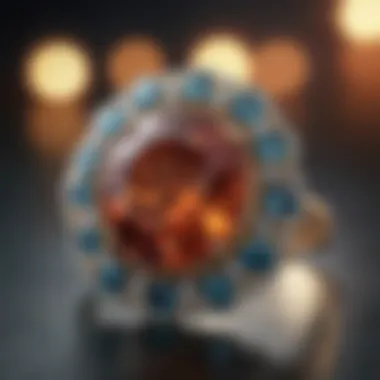
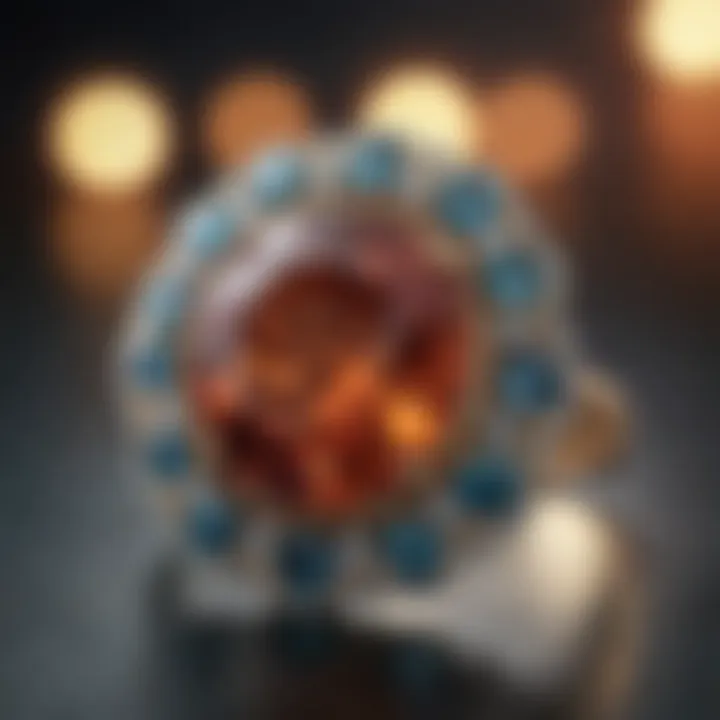
"The advancements in cutting techniques are not just about aesthetics; they raise the bar for quality assurance within the gemstone industry."
Market Demand for Unique Finishing Techniques
As consumers become more discerning, there’s a growing demand for gemstones that exhibit unique finishing techniques. Buyers are increasingly looking for distinctive characteristics that set stones apart from the rest. Thus, finishes such as satin, high-polish, or even rustic textures are becoming appealing. Each of these methods creates a different visual identity and tactile experience that resonates with various customer preferences.
- Satin finishes: Provide a softer, understated elegance, often favored by those who appreciate minimalism.
- High-polish finishes: Maximize shine and luster, making them popular for statement pieces.
- Rustic textures: Offer a natural look, appealing to consumers who value individuality.
The market is also seeing interest in organic and ethical finishing techniques that emphasize sustainability. Buyers want to know that their purchase aligns with their values, and producers who can meet this demand will benefit tremendously. Some artisans are even exploring eco-friendly polishing methods that rely on natural materials, further enhancing the gemstone's appeal.
Psychological Aspects of Gemstone Purchase
The decision to purchase a gemstone is rarely just a matter of finances or aesthetics. This process is often deeply intertwined with the buyer's emotions and psychological state. When it comes to a 3.5 carat gemstone, the implications stretch far beyond mere weight and brilliance. Understanding these psychological factors can significantly enhance both buying experiences and customer satisfaction.
Understanding Consumer Behavior
Consumer behavior in the gemstone market shows fascinating patterns. An individual’s decision can stem from some personal motivations that go beyond logic. For many, the act of purchasing a gemstone is enmeshed with significant life events—think engagements, anniversaries, or even personal milestones. Rather than simply a transaction, these purchases often represent milestones or emotional aspirations.
- Aspirational Purchases: A 3.5 carat gemstone captivates attention not only because of its stunning aesthetics but also due to its perceived status. A larger gem may feel like a statement of success or a tangible testimony to personal achievements.
- Influence of Social Proof: Observing how others perceive or endorse certain gemstones can heavily impact choices. If a gemstone is showcased in popular culture or among trusted circles, it becomes more desirable.
- Past Experiences: Personal memories associated with gemstones can influence purchasing behavior profoundly. For instance, if a consumer has fond memories of their grandmother's heirloom jewelry, they may be tempted to mimic that purchase independently, further embedding emotional considerations into their decision.
These factors guide consumers, nudging them toward certain choices underpinned with intangible justifications. Understanding these drivers equips sellers with insights that can improve marketing strategies or tailoring approaches based on buyer psychology.
The Emotional Value of Gemstones
The emotional weight of a gemstone purchase cannot be undervalued. A 3.5 carat gem isn’t simply a piece of jewelry; it embodies sentiments, memories, and legacy. This aspect of gemstones fosters connections that can be both profound and lasting.
"In the world of gemstones, their value often lies beyond the tangible; it resides in the heart of the beholder."
Consider a few key emotional triggers at play when someone purchases such a substantial gemstone:
- Symbolism and Meaning: Many gemstones carry specific meanings or associations, often tied to love, fidelity, and prosperity. For instance, diamonds represent eternal love; this is why they’ve become a staple for engagement rings.
- Connection to Heritage: For some buyers, gemstones can encapsulate family traditions. A 3.5 carat stone can signify a rite of passage, passed down through generations, or even sourced directly from a cherished location.
- Investment in Memories: The physical beauty of the stone is matched by aspirations tied to its ownership. This can create an almost nostalgic feeling, emphasizing personal stories that may be forged around special celebrations or achievements.
Ethical Considerations
In the realm of gemstone purchasing, ethical considerations hold a critical place in shaping consumer values and shaping market behaviors. This dimension explores not only the origins of the gemstones but also the broader implications of their acquisition. As the awareness surrounding ethically sourced products increases, so does the demand for transparency in the supply chain of gemstones. For a 3.5 carat gemstone, the ethical standpoint isn’t merely an option—it is becoming an expectation.
Sustainability in Gemstone Sourcing
When delving into sustainability in gemstone sourcing, the focus lies on practices that minimize environmental impact and promote social equity. Many gemstone enthusiasts today are more inclined to seek out responsibly sourced stones. This means gemstones that come from mines with fair labor practices, where workers are treated equitably and compensated fairly for their efforts.
An example of such a movement is the rise of conflict-free diamonds, which signifies a broader trend toward ethical sourcing. Consumers advocating for sustainable mining methods not only contribute to the preservation of the environment but also champion the rights of workers engaged in this industry. Research has shown that brands that emphasize ethical practices often enjoy higher consumer loyalty.
To further this cause, one can explore certification systems like the Responsible Jewelry Council or the Kimberley Process that aim to ensure ethical sourcing. It’s become increasingly important for buyers to inquire about the provenance of a gemstone before making a purchase.
Impacts of Mining Practices
The impacts of mining practices stretch far beyond mere extraction of gemstones. Poor mining practices can lead to devastating consequences, including environmental degradation, loss of biodiversity, and the destabilization of local economies. Unregulated mining operations often leave scars on the earth that are challenging to repair. For instance, the use of harmful chemicals in the extraction process, like cyanide and mercury, can infiltrate local water supplies, impacting not only wildlife but also human health.
"The methods used to mine gemstones can be just as crucial as the beauty of the stones themselves. Understanding these impacts can guide consumers to make more informed choices."
Moreover, communities dependent on mining for livelihood often face moral dilemmas. Ensuring that mining contributes positively to local development can strengthen communities if done right. Encouraging companies to adopt socially responsible mining practices can lead to improved conditions all around, fostering a more sustainable future for both people and the environment.
Maintaining a focus on ethical sourcing when considering a 3.5 carat gemstone isn’t just a fleeting trend. It represents a shift toward increased responsibility among consumers and serves as a call to action for the industry to align better with sustainable practices.
Future Perspectives
The future of 3.5 carat gemstones is not just a fleeting topic; it serves as a mirror reflecting the ever-evolving landscape of the jewelry market. As consumer preferences shift, influenced by both economic conditions and aesthetic inclinations, understanding these trajectories becomes paramount for buyers and sellers alike. Anticipating future trends allows stakeholders to make informed decisions. For enthusiasts and collectors, this insight creates a pathway to potentially profitable investments.
Predicted Market Trends for Higher Carat Stones
In the realm of gemstone investment, larger stones often attract a premium price. Market analysts predict that as global wealth increases, particularly in emerging markets, the appetite for higher carat stones will continue to grow. The demand isn’t merely about size but also the perceived value and exclusivity that accompany a 3.5 carat gemstone.
- Aesthetic Trends: Larger gemstones are increasingly favored for statement pieces that are visible and eye-catching. Consumers are likely to gravitate towards designs that highlight the stone, positioning larger carats as a preferred choice.
- Cultural Shifts: Traditions surrounding engagement and gifting are changing. With more people willing to step away from conventional standards, there’s a greater inclination towards investing in higher carat gemstones to celebrate significant milestones.
- Investment Security: As tangible assets, gemstones can provide a hedge against inflation. Higher carat stones, particularly those that are rare or hold unique characteristics, are seen as secure investments in uncertain financial climates.
Given these trends, it’s critical for both investors and buyers to stay updated on market indicators, ensuring they are positioned strategically to take advantage of shifts in demand.
Technological Innovations Shaping the Market
Technological advancements are playing a pivotal role in the transformation of the gem market. From mining practices to cutting-edge tools for assessment, various innovations are reshaping how gemstones are valued and marketed.
- Precision Cutting Technologies: Modern equipment allows for more precise and intricate cuts. This enhances the beauty and brilliance of 3.5 carat stones, making them more desirable.
- Blockchain for Provenance: Transparency has become paramount. Utilizing blockchain technology, consumers can trace the journey of their gemstones, verifying authenticity and ethical sourcing. This builds trust in an industry sometimes shadowed by issues of conflict stones.
- Synthetic Alternatives: The rise of lab-created gemstones offers a competitive option to natural stones. These alternatives may not carry the same allure for purists but serve an audience looking for affordability and ethical considerations.
As these technologies mature, they’ll likely influence pricing strategies and consumer perceptions, making it imperative for stakeholders to adapt swiftly.
“The only constant in the gem market is change. Awareness of future trends not only assists in planning but is essential for thriving in this beautiful, yet complex industry.”
Ending
The significance of the conclusion in this article cannot be overstated. A well-crafted conclusion is not just a literary wrap-up; it serves as a reflective lens for the entire discourse on 3.5 carat gemstones. Throughout the article, we have delved into the nuances of carat weight, the societal perceptions around gemstones, and their implications in the market and as investments. By summarizing these key insights, the conclusion ensures that readers walk away with a consolidated understanding of the topic.
Summarizing Key Insights
In reviewing the various aspects surrounding 3.5 carat gemstones, several critical insights emerge:
- Carat Size and Market Reflection: The 3.5 carat weight often strikes a balance between being perceived as luxurious yet attainable. This size garners attention without venturing into the realm of ostentation.
- Cultural and Historical Aspects: The emotional and symbolic weight of gemstones has endured across cultures, and the 3.5 carat stone occupies a prominent position within that narrative.
- Investment Viability: For collectors and enthusiasts, investing in a 3.5 carat gemstone offers potential for value appreciation. The appeal lies in its rarity combined with demand, which keeps the market vibrant.
- Care and Authenticity: Knowledge of maintenance and sourcing authenticity is crucial. Proper care not only preserves the stone’s beauty but also upholds its market value.
By encapsulating these points, the conclusion serves as a potent reminder of the depth and gravity associated with choosing a gemstone of this caliber.
Considerations for Future Buyers
As readers contemplate acquiring a 3.5 carat gemstone, several considerations ought to guide their decisions:
- Research is Key: Gathering information about cuts, colors, and clarity before making a purchase is fundamental. Understanding the grading reports can be a game changer in the decision-making process.
- Market Awareness: Awareness of current market trends can empower buyers. Engaging in discussions on platforms like reddit.com, where gemstone enthusiasts exchange insights, can be enlightening.
- Reputable Sources: Working only with reputable dealers is paramount. Certifications should be non-negotiable in the buying process to ensure authenticity.
- Long-term Vision: Viewing the purchase as a long-term investment rather than a fleeting indulgence shifts the perspective. This viewpoint can influence not only choices at the point of sale but also the appreciation of the gem over time.







